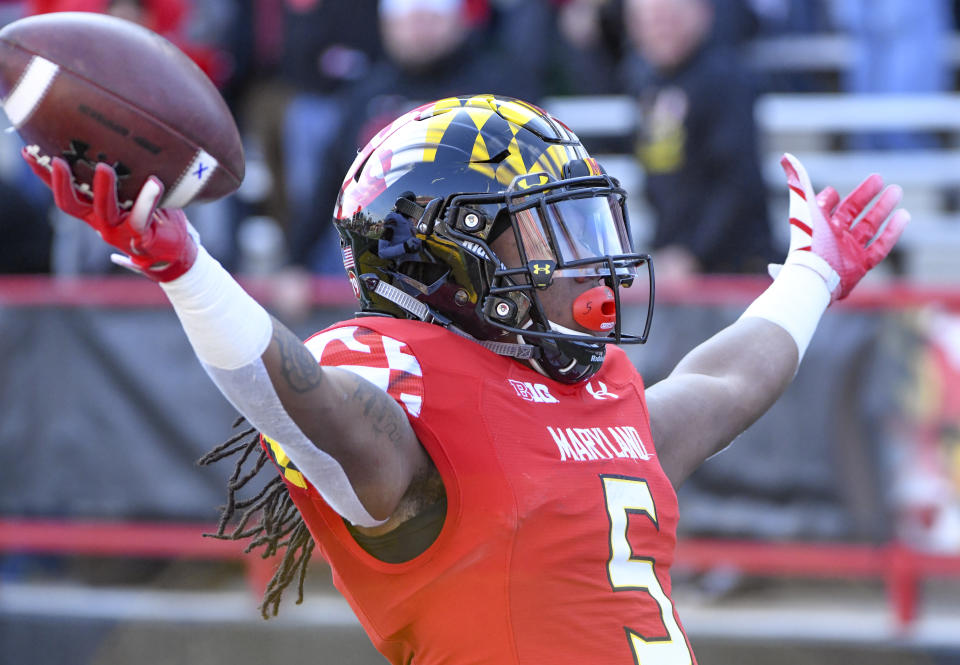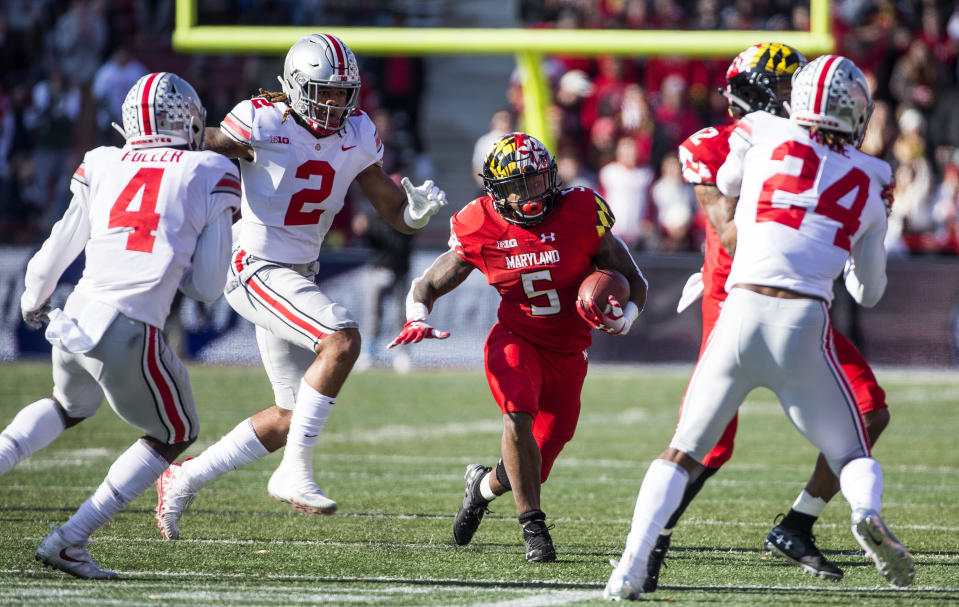Maryland's Anthony McFarland Jr. says NFL draft decision hinges on one key factor

CHICAGO — Maryland running back Anthony McFarland Jr. had his coming-out party to the nation in a brilliant performance last fall in a near-upset of Ohio State, helping make him one of the most anticipated playmakers of the 2019 college football season.
In the Terps’ 52-51 nationally broadcast overtime loss to the Buckeyes last November, McFarland rushed for 298 yards on only 21 carries, scoring touchdowns of 81 and 75 yards and later ripping off a 52-yarder on a third-and-1 run into the Ohio State red zone.
That was McFarland’s showcase game — not just for college football fans but for NFL scouts and Maryland’s opponents, too.
“It was a big confidence booster,” McFarland said Thursday at Big Ten Media Days, “but what happened last year is out the window.
“I feel like I haven’t done much yet. I want to do way more than I did last year. And I want to make it to Indianapolis.”
McFarland was talking about the site of the Big Ten Championship game, of course. But it’s also a city he could end up in at the NFL scouting combine a few months later.
Although McFarland is entering his redshirt sophomore season, he’ll be draft-eligible for 2020 — and it he improves on a banner freshman campaign, it might not be that shocking to see him come out with two years of eligibility remaining.
Maryland RB Anthony McFarland Jr. said his mother gave him his neckwear — an “old-fashioned tie,” she told him
I say it’s a big 👍🏻👍🏻 pic.twitter.com/XeQj1g8wmA— Eric Edholm (@Eric_Edholm) July 18, 2019
Why Anthony McFarland Jr. could declare in 2020
There will be one key factor, McFarland said, when it comes time to make that call, whether it’s after this coming season or down the road.
“Health,” he said. “I know my family is going to support whatever I do. But that will be the decision, how healthy I am. That will determine whatever I do.
“But who knows? I could be in college all four years, or not. But when the time is right, I’ll know.”
We’re in an era when less work for running backs often is viewed as a positive to NFL scouts. Backs are no longer the workhorses they once were on the pro level, but there still are college backs who are ground down with high carry totals for two, three or even four seasons before they enter the NFL.
McFarland is not built to be that type of back. He’s listed at 5-foot-8 and 196 pounds with speed and elusiveness high on his list of quality traits. Ideally, McFarland would be a great complementary back whose pitch counts are kept limited — “like an Alvin Kamara,” he offers.
McFarland redshirted in 2017 before rushing for 1,034 yards on a mere 131 rushes — a whopping 7.9-yard average — and four TDs. His receiving production was quite limited, but that could be overlooked at the time.
Doing more statistical damage than any back has ever done against Ohio State will do that. The closest since the 2000 season was a 228-yard, three-TD game by future NFL back Tevin Coleman (Indiana) back in 2014.

What the plan is for Anthony McFarland this season
New Maryland head coach Mike Locksley arrived from Alabama, where he recruited McFarland before the RB spurned the Crimson Tide for the local team.
“He was a Boys and Girls Club legend in the DMV area,” Locksley said. “By the time he was a sixth-grader — those long runs you saw out of him last year, they were staples of who Anthony was [back then].”
McFarland suffered a leg injury that caused him to miss his senior season of high school. Bama backed off slightly, perhaps, and the Terps pounced in what was viewed as a huge recruiting score.
“I am really happy he’s here now,” Locksley said of the player he once missed out on. “He’s got big-play ability, speed, acceleration, vision, catches the ball well and he’s really competitive.”
Locksley last coached Josh Jacobs and Damien Williams, first- and third-round picks this past April. Bama also had Najee Harris, who will be the Crimson Tide’s featured back this season, albeit with a far different style than what Locksley’s big-play runner at Maryland this season.
But Locksley found ways to use all his quality backs at Bama, keep them fresh and maximize their playmaking.
“He just wants to showcase my ability,” McFarland said of his new coach whom he first met when he was in eighth grade. “[Locksley] knows what it takes to get players to the next level. That’s one of my goals. My first is to win a championship. But he knows how to showcase guys’ abilities and get them to the next level.”
If there’s an area where McFarland can improve, it’s in the pass game. He caught a mere seven passes for 73 yards in 12 games, with 53 of those yards coming early last season against Bowling Green. For a smaller, quicker back, McFarland hasn’t yet unlocked that phase of his game.
“It’s always tough with these guys who make big plays, it’s [learning how to] play without the football,” Locksley said. “Pass protection. Running the right routes the right way. Opening things up for others.
“We’ll continue to develop those habits out of Ant.”
McFarland knows it now, too.
“That’s the thing he stressed to me: It’s hard to stay on the field in college and the pros if you don’t know how to pass block,” McFarland said.
But his assignments should be simple regardless. The Terps have four pass protections, McFarland said, and the Terps have a deep running back room, even with Ty Johnson moving on.
Teammates Javon Leake and Lorenzo Harrison averaged 9.1 and 8.4 yards per carry, respectively, in limited duty last season. It feels like the carries will be divvied up to a degree, along with short-yardage ace Tayon Fleet-Davis.
So there’s the perfect recipe — run-savvy coach, complementary talent, big-play ability — for McFarland to showcase enough explosiveness in this one season for him to consider the draft despite having two years of eligibility left.
And even though Jacobs is a different type of back, his 317-touch career at Bama is proof that the NFL is adverse to low college workloads. Kamara (311) is another good example. At 139 touches to date, McFarland has a ton of tread left.
He’s one of the most fascinating runners in the country this season, and we’ll be curious to see how he handles his decision on the NFL at year’s end.
More from Yahoo Sports:
